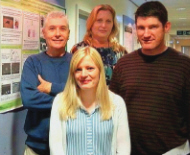



New Project to Measure Boar Taint on Slaughterhouse Line
UK - A new project aims to explore how technology can be used in slaughterhouses to prevent meat with boar taint from reaching consumers.
Boar taint is an important issue in the UK and EU, with up to 10 per cent of carcasses from uncastrated male pigs being affected by an offensive odour and/or taste.
PhD student, Kelly Westmacott, has recently started a project to investigate how technology can be used in abattoirs to prevent tainted meat from reaching the consumer.
Ms Westmacott explained in Abattoir News: “My BPEX-funded PhD studentship is being carried out at the Centre for Research in Biosciences, University of the West of England Bristol (UWE), and in partnership with JSR Genetics Ltd.
She continued: “It aims to assess a novel technology which we have recently developed and patented and, most importantly, look at how it can be integrated into current abattoir practices.”
Expanding on the science behind the project, she says that the technology is capable of measuring boar taint in pig carcasses and has the potential to be an intrinsic part of the pig processing line.
“Research has found that there are several naturally-occurring compounds within the pig tissue that are responsible for taint. The concentration of these compounds is principally related to the sexual maturity of the boars,” explained Ms Westmacott.
She added that, unlike most European countries and elsewhere, the UK does not routinely castrate boars to prevent taint but instead, slaughters them at a younger age.
“However, this could change across the EU, as animal welfare concerns have led to an initiative on the voluntary ban of the surgical castration of piglets by 2018.
“As a consequence, the prospect of this ban has accentuated the already pressing need to develop a robust analytical system that can simultaneously detect the taint compounds at the point of slaughter.”
This will avoid tainted meat entering vulnerable sectors of the market and creating consumer dissatisfaction.
Consumer confidence is a vital aspect of any food sector, and studies performed across the EU, including the UK, have indicated that around only half of customers who have experienced an abnormal odour would re-purchase pork (European Commission ALCASDE Project Report, 2009).
“These statistics highlight the scale of the issue and, while there are welfare benefits of not castrating, ultimately this matter has a serious impact on the economy of the UK pig industry,” acknowledgeed Ms Westmacott, who added that at the present time a number of alternatives to surgical castration have been considered to prevent boar taint, such as genetic selection, vaccination, dietary manipulation and other management strategies.
However, Ms Ms Westmacott maintained that all of these alternative methods still require a rapid, economically viable, boar taint monitoring system to ensure their effectiveness.
She said: “At present, no technology exists to provide on-line detection of boar taint in a rapid, cost-effective manner suitable for the industry.
“This four-year project will provide information essential to enable the implementation and integration of such a system, to efficiently determine the status of pork before it leaves the abattoir.”
She concluded by saying that, implemented correctly, this system could help to improve customer satisfaction and increase the competitiveness of the UK pig industry by allowing heavier carcasses to be produced.








